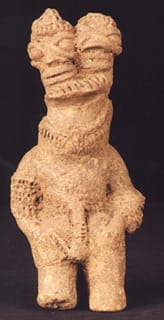Bicephalous Komaland Terracotta Sculpture, 13th Century CE - 18th Century CE
Terracotta
5 x 10.5
PF.1301 (LSO)
This extraordinary sculpture is a bicephalous anthropomorphic figure from one of Africa’s least understood groups; the Koma people of Northern Ghana. The figure is remarkable even within the remit of...
This extraordinary sculpture is a bicephalous anthropomorphic figure from one of Africa’s least understood groups; the Koma people of Northern Ghana. The figure is remarkable even within the remit of known Komaland styles. It represents a single standing male with short, stocky legs, short arms and an elongated yet solid torso. Infra-cranial detailing is obtained through hatching and pricking of the surface with sharp implements. The neck resembles a collar, from which protrudes a columnar mass surmounted by two small heads, side by side. They are essentially the same, with very large, relief-rimmed eyes, pointed noses and straight, thick-lipped mouths. They are wearing conical headwear, which matches the “collar” around their necks. Each arm is ringed with dots that seem to suggest armlets; the left hand appears to be holding something, perhaps a club, but this has become eroded through time. The phallus is disproportionately large and reaches vertically to the level of the navel.
The Komaland people are almost completely obscure, and since the original discovery of their artefacts in 1985 very little further research has been carried out. Basic dating indicates a range of perhaps 500 years between the 13th and 18th centuries. They are known to have been very able ceramicists, and made pots, figures, heads, talismans (anthropomorphic and zoomorphic) and a variety of other items; they were also, unusually, competent metalworkers, and produced a plethora of weaponry and ornate helmets. Their society was presumably sedentary, agricultural and hierarchical, as indicated by the range of crafts available, the tumuli in which they were found, and the size of the sites.
In terms of ceramics, there is an unusually high percentage of deformed and heavily stylised figures; the significance of this remains uncertain. In the current case, a bicephalous portrait could have many meanings, none of them currently falsifiable. It could represent a “real” person, who was immortalised due to his/her rarity. This explanation is powerful in light of the West African tendency towards twinning, which remains high to this day among the Yoruba and adjacent groups. Alternatively it could be a figure from Koma mythology, reproduced in his honour, or even a fanciful construction or experiment by a spectacularly imaginative and accomplished ceramicist.
Whatever the reason, however, this is a rare and fascinating piece of ancient African art.
The Komaland people are almost completely obscure, and since the original discovery of their artefacts in 1985 very little further research has been carried out. Basic dating indicates a range of perhaps 500 years between the 13th and 18th centuries. They are known to have been very able ceramicists, and made pots, figures, heads, talismans (anthropomorphic and zoomorphic) and a variety of other items; they were also, unusually, competent metalworkers, and produced a plethora of weaponry and ornate helmets. Their society was presumably sedentary, agricultural and hierarchical, as indicated by the range of crafts available, the tumuli in which they were found, and the size of the sites.
In terms of ceramics, there is an unusually high percentage of deformed and heavily stylised figures; the significance of this remains uncertain. In the current case, a bicephalous portrait could have many meanings, none of them currently falsifiable. It could represent a “real” person, who was immortalised due to his/her rarity. This explanation is powerful in light of the West African tendency towards twinning, which remains high to this day among the Yoruba and adjacent groups. Alternatively it could be a figure from Koma mythology, reproduced in his honour, or even a fanciful construction or experiment by a spectacularly imaginative and accomplished ceramicist.
Whatever the reason, however, this is a rare and fascinating piece of ancient African art.



